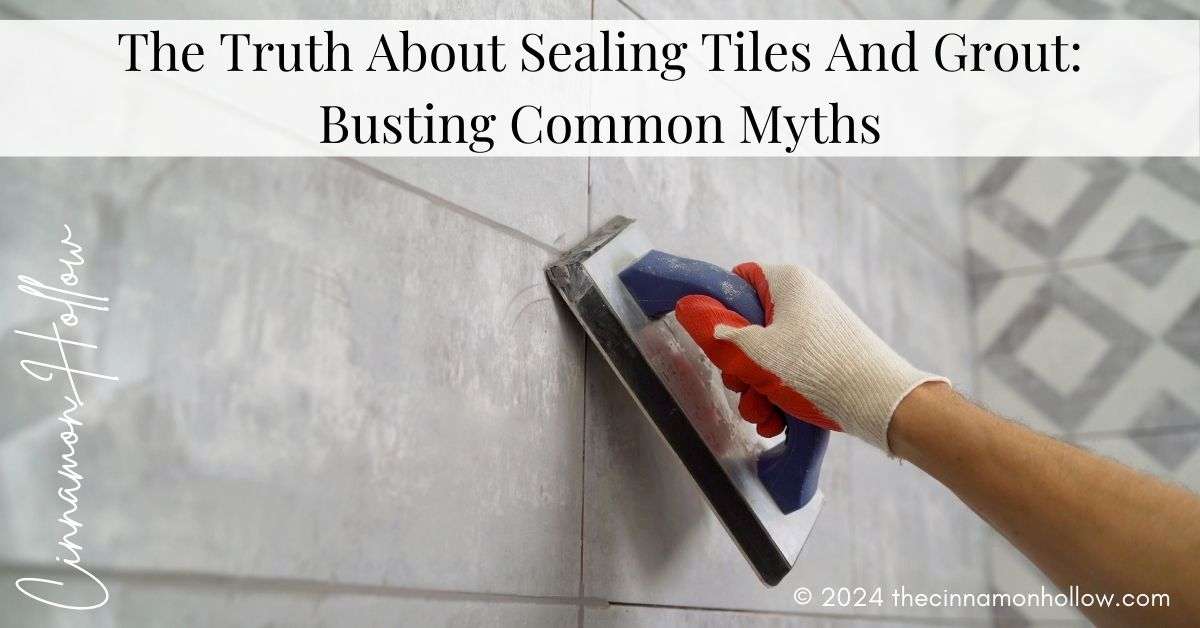The Importance Of Sealing Tiles And Grout
Sealing tiles and grout is an essential step in ensuring the longevity and appearance of your tiled surfaces. Tiles and grout can absorb moisture, harbor mold, and accumulate stains over time, which can deteriorate their quality and appearance. Implementing proper sealing tile techniques can create a protective barrier against these damaging elements. By having this protective barrier, you maintain the aesthetics and durability of your tiles for years to come, ensuring they look as good as new.
Ignoring this crucial maintenance step can lead to costly repairs and even replacement. Water and other substances can seep into the grout, weakening it and leading to potential mold growth. This can spell disaster for areas like kitchens and bathrooms where hygiene is paramount. Therefore, understanding the benefits of sealing is vital in preserving your investment and avoiding unnecessary expenses in the future.
Common Myths Debunked
There are several misconceptions when it comes to sealing tiles and grout. One common myth is that grout does not need to be sealed. In reality, grout is porous and susceptible to staining and moisture damage. For example, sealing grout can prevent these issues, ensuring it stays clean and intact over time. This commonly overlooked process can significantly prolong the life and appearance of your grout lines.
Another myth is that all tiles need the same type of sealer. Different materials require specific products to achieve the best results. For instance, natural stone tiles need a different sealer compared to ceramic or porcelain tiles due to their unique compositions and properties. Knowing these nuances is critical, as using the wrong sealer can result in inadequate protection or, worse, damage to your tile surfaces. This can lead to needing to replace tiles far sooner than expected, which can become quite expensive.
Proper Sealing Techniques
It takes more than just smearing a substance on your grout and tiles to have a good seal. Before sealing, the surfaces need to be carefully cleaned to get rid of any dirt, grime, and old sealants that could get in the way of freshly applied sealers. It’s crucial to use a premium cleaner that’s suitable for the sort of tile you have. Following cleaning, use a brush or roller to apply the sealer evenly and thoroughly. Some tools and methods can help get a professional finish, including utilizing a fine brush for grout lines. Follow the manufacturer’s recommendations and let the sealer dry completely to ensure a robust and long-lasting barrier. Your tiles and grout may receive less protection and a less effective seal if you skip steps or speed up the procedure.
Follow proper sealing techniques to ensure adequate protection and subpar results. This not only affects the appearance of your tiles but can also reduce their lifespan and increase the frequency at which they need to be resealed. Taking the time to do it right can save you headaches and additional costs down the road, ensuring that your tiled surfaces remain pristine and well-protected.
How Often Should You Seal Your Tiles And Grout?
The frequency of sealing depends on several factors, including the type of tiles and grout, the area of installation, and the amount of foot traffic. Typically, high-traffic areas like kitchens and bathrooms should be resealed annually because they are more prone to wear and tear, as well as exposure to moisture and stains. For areas with less foot traffic, such as guest bathrooms or decorative tiles in niche areas, resealing every two to three years might suffice to maintain their protective barrier.
You can tell when it’s time to reseal your tiles and grout by routinely looking for wear indicators like discoloration, staining, or efflorescence—a whitish, powdery deposit on the grout’s surface. By doing this, you can be sure they stay in excellent shape and continue to offer the protective advantages required to preserve their usefulness and visual appeal. Being proactive can help you avoid minor problems growing into bigger ones that call for more involved and expensive fixes.
Choosing The Right Sealer
Selecting the appropriate sealer is crucial to achieving the best results. There are generally two types of sealers: penetrating sealers and surface sealers. Penetrating sealers, as the name implies, soak into the grout and provide long-lasting protection against moisture and stains from within. These sealers are often preferred for natural stone tiles because they maintain the material’s natural look without adding any sheen. Surface sealers, on the other hand, form a protective layer on top of the tiles and grout, offering excellent resistance to dirt, grime, and bacteria. These are suitable for tiles that do well with a glossy finish.
Knowing how these products differ from one another will help you choose wisely and guarantee that your grout and tiles are protected to the best of their abilities. To choose the ideal sealer type for your particular tiles and uses, refer to the manufacturer’s specifications or get professional guidance. Making an informed decision can help you avoid issues related to utilizing an incompatible product and assure long-term protection.
Sealing Special Tiles: What To Consider
Similar to natural stone, specialty tiles call for specific sealing agents and methods of application. Due to their high porosity and ease of staining, these materials—which include marble, limestone, and travertine—cannot be adequately sealed. These tiles can be shielded from harm and have their natural beauty maintained by applying a sealant made especially for natural stone. Furthermore, to guarantee long-term durability, some tiles might need to be sealed with multiple coats of sealer or require particular upkeep after sealing.
Research the specific needs of your tile materials to choose the suitable sealer and application method. This knowledge ensures you provide the best possible care, protecting the integrity and appearance of your unique tiles. For example, natural stone sealers are formulated to penetrate deeply into these porous materials, providing a more substantial barrier against moisture and stains. Understanding these details can help you achieve a lasting, beautiful finish that showcases the unique qualities of your tiles.
Maintaining Your Sealed Tiles And Grout
Regular maintenance is critical to prolonging the life of your sealed tiles and grout. Simple practices like adhering to proper cleaning routines can keep your sealed surfaces in pristine condition. Using gentle, pH-neutral cleaning solutions and a soft brush can help remove dirt and grime without damaging the sealer. Harsh chemicals or abrasive tools should be avoided, as they can compromise the protective barrier and cause damage over time.
Additionally, periodic inspections can help identify areas where the sealer may be wearing off, allowing you to address these issues promptly. For areas that see frequent water exposure, such as shower floors, taking preventive measures like using squeegees to remove excess water can help prolong the effectiveness of the sealer. By following these tips and debunking common myths, you can ensure your tiles and grout remain protected, beautiful, and long-lasting.
Key Takeaways
- Understand the importance of sealing tiles and grout to maintain durability and appearance.
- Learn about common myths and misconceptions surrounding tile and grout sealing.
- Discover real-life examples to help you make informed decisions about sealing practices.







